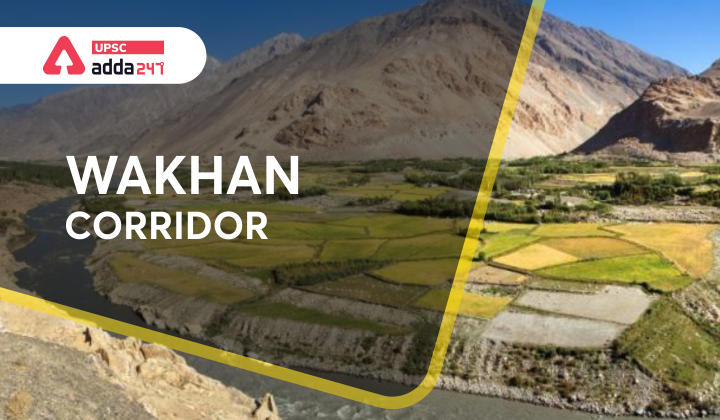G.S. Paper 2: India and its neighbourhood relations – Bilateral, regional and global groupings and agreements involving India and/or affecting India’s interests.
Where it is Located?
- The Wakhan Corridor, significantly pan shaped, is located at the crossroads of five countries vis. Afghanistan, Tajikistan, China, Pakistan and India.
- It is a narrow, inhospitable and barely accessible strip of land.
- This Corridor was one of the most important junction points along the ancient Silk Road.
- As per records available, the southern limit of the Wakhan Corridor was formed by the Durand Line (South) while the northern part came into existence as a result of the Pamir Boundary Commission of 1895.
- The area at the tip of the Wakhan Corridor, in Little Pamirs, is evolving into a key crossroad for CPEC as it is crucial for China’s Belt and Road Initiative (BRI) in the region. China, now seemingly have plans to convert the corridor into a curious case of the ‘Corridor of Power or Conflict’.

Importance for India:
- The geographical location of the Wakhan Corridor makes it geo-strategically significant for India in the context of Central Asia.
- The Corridor has been central to the ancient Silk Road, Great Game, and Cold War, and now China seemingly has plans to convert the Wakhan Corridor into a curious case of ‘Corridor of Power or Conflict’.
- From the Indian perspective, Gilgit Baltistan and Wakhan Corridor region could emerge as India’s Gateway to Central Asian Republics and their expanding markets.
China’s Interset in Wakhan Corridor:
- Afghanistan and China share a 74km (46 miles) border along the remote Wakhan Corridor.
- China has always been wary of a narrow, isolated strip of Afghan land high in the mountains becoming a conduit for Uygur militancy in Xinjiang.
- The Taliban’s coming to power in Afghanistan has compounded China’s worries of a spillover, given the militant Islamic group’s ties with the ETIM.
China’s Military Bases in Tajikistan
- China has built a military base in Tajikistan near the Afghan border that it has been quietly operating and will also build a new base under Tajik in the eastern Gorno-Badakhshan autonomous province near the Pamir mountains.
- It is strategically important based on the China-Tajikistan-Afghanistan tri-junction and the Wakhan Corridor, where China shares a less than 100 km border with Afghanistan.
- China’s interest in the base is tied to its security concerns in its western Xinjiang region, which shares a border with Afghanistan and Tajikistan.
- The base, once full control has been transferred, will become only the second known overseas Chinese security facility, after Djibouti near the Horn of Africa.
(Note: Russia and India are among countries that already have a military presence in bases in Tajikistan.)
| Central Asia:
· The Central Asian Region includes Kazakhstan, Kyrgyzstan, Uzbekistan, Tajikistan, Turkmenistan, Mongolia, and Afghanistan. · The specific geopolitical interests of superpowers have had a far-reaching as well as a long-lasting impact on both— the security and economic affairs of the Central Asian region. |
What is ‘New Great Game of the 21st century?
- In a 2020 study, the New Great Game was described as a form of “Civilizational Colonialism” in border regions and areas of territorial disputes, united by their location in High Asia or “The Roof of the World”.
- The recent geopolitics of expanding Chinese BRI and CPEC, the withdrawal of NATO forces from Afghanistan and the huge natural resource pool in Central Asia has brought this region back into central focus.
What does India need to do?
India needs to adopt the stated National Vision, Grand Strategy and de novo approach to realise the geostrategic significance of Gilgit-Baltistan in the context of the Wakhan Corridor as Gateway of India to Central Asia in the 21st century.



 TSPSC Group 1 Question Paper 2024, Downl...
TSPSC Group 1 Question Paper 2024, Downl...
 TSPSC Group 1 Answer key 2024 Out, Downl...
TSPSC Group 1 Answer key 2024 Out, Downl...
 UPSC Prelims 2024 Question Paper, Downlo...
UPSC Prelims 2024 Question Paper, Downlo...




